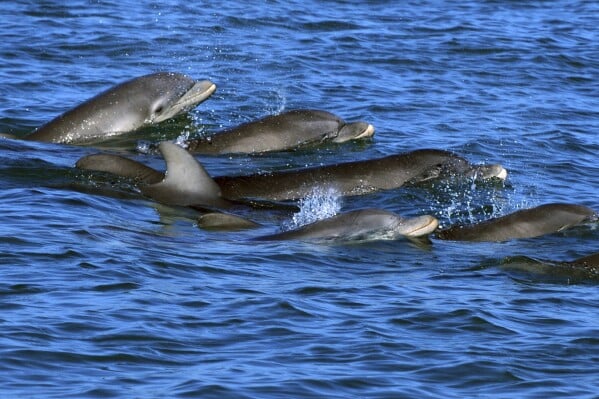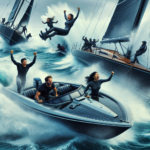So you’re heading out on a boat trip and you can’t wait to immerse yourself in the beauty of the ocean. But before you set sail, there’s something important you need to know – marine wildlife and how to navigate around them. Understanding the behavior of these majestic creatures and knowing how to peacefully coexist with them is crucial for both their well-being and your safety. In this article, we’ll shed light on what you should know about marine wildlife and provide you with some helpful tips on how to navigate around them without causing harm or disturbance. So grab your life jacket and let’s embark on this educational journey together!
Understanding Marine Wildlife
Definition of Marine Wildlife
Marine wildlife refers to the diverse and fascinating range of organisms that inhabit the world’s oceans and other bodies of saltwater. This broad term encompasses a wide variety of species, including fish, mammals, reptiles, birds, and invertebrates, such as crustaceans and mollusks. From majestic whales and playful dolphins to colorful coral reefs and intricate marine plants, marine wildlife is essential for maintaining the delicate balance of marine ecosystems.
Importance of Marine Wildlife
Marine wildlife plays a crucial role in maintaining the health and stability of our oceans. These organisms contribute to the overall biodiversity of our planet and help regulate global climate systems. They also support the economies of coastal communities by providing valuable resources, such as seafood, as well as attracting tourists interested in diving, snorkeling, and wildlife watching. Furthermore, marine wildlife serves as indicators of ecosystem health, helping scientists monitor and assess the impacts of human activities on our oceans.
Types of Marine Wildlife
The world’s oceans are home to an astonishing array of marine wildlife. Some of the most iconic species include whales, dolphins, sharks, sea turtles, seals, and sea birds. These larger marine animals often capture our attention and awe, but it’s essential to acknowledge the countless smaller and less visible organisms that are just as vital to marine ecosystems. These include colorful fish, delicate corals, microscopic plankton, and even the tiny crustaceans that form the base of the marine food chain. Each species has its unique characteristics and adaptations that allow them to thrive in their specific marine habitats.
Interactions with Marine Wildlife
Respecting Marine Wildlife
When encountering marine wildlife, it’s crucial to approach them with respect and admiration. Keeping a safe distance and observing animals in their natural environments without interfering or causing distress is the best way to interact with these creatures. Marine wildlife should never be touched or pursued, as this can disrupt their behavior, stress them, or even cause injuries.
Potential Risks
While marine wildlife is awe-inspiring and captivating, it’s important to be aware of potential risks associated with close interactions. Some larger marine animals, like sharks or marine mammals, can exhibit unpredictable behavior if they feel threatened or provoked. Certain species may also carry diseases or parasites that could be harmful to humans. It’s crucial to stay informed and follow the guidance provided by local authorities and experts when interacting with marine wildlife.
Legal Regulations
To protect marine wildlife and their habitats, various legal regulations exist worldwide. These regulations may encompass restrictions on fishing practices, whale watching guidelines, protected marine areas, and conservation measures. It’s essential to familiarize yourself with the specific regulations of the region you are visiting or exploring to ensure you are not unintentionally violating any laws. By adhering to these regulations, you can contribute to the preservation and conservation of marine wildlife.
Recognizing Marine Wildlife
Identifying Common Species
Being able to identify common species of marine wildlife is not only exciting but also helps develop a deeper appreciation for the environments they inhabit. Understanding the characteristics and features of different creatures can enhance the enjoyment of marine wildlife encounters. Field guides, photographs, online resources, and local experts are valuable sources of information that can assist in the identification process.
Understanding Behavior
observing and understanding the behavior of marine wildlife can provide insights into their natural history and enhance the overall experience of interacting with them. Many species have unique behaviors, such as migratory patterns, feeding techniques, or social structures. By observing and learning about these behaviors, you can gain a better understanding of the needs and vulnerabilities of marine wildlife, helping foster a connection to these amazing creatures.
Signs of Marine Wildlife Presence
Even if you can’t directly see marine wildlife, there are often signs of their presence that can be observed. These signs include splashes, breaches, blowhole sprays from whales, or the presence of seabirds hovering or diving in specific areas. Additionally, paying attention to underwater signs such as bubbling or movement in the water can indicate the presence of fish or other marine creatures. Being aware of these signs and actively looking for them can greatly enhance your chances of encountering marine wildlife.
Protecting Marine Wildlife
Marine Protected Areas
Marine protected areas (MPAs) are designated areas within the ocean where certain activities, such as fishing or mining, are restricted or prohibited to protect marine ecosystems and wildlife. These areas serve as havens for marine wildlife populations to thrive, free from excessive human interference. Supporting the creation and expansion of MPAs is crucial in safeguarding marine wildlife and ensuring the long-term sustainability of our oceans.
Conservation Efforts
Numerous organizations and initiatives work tirelessly to conserve marine wildlife and their habitats. Through research, education, advocacy, and on-the-ground projects, these efforts aim to raise awareness, promote sustainable practices, and develop effective conservation strategies. By supporting and actively participating in conservation initiatives, you can contribute to the preservation of marine wildlife and help safeguard their future.
Reducing Human Impact
One of the most significant threats to marine wildlife is the impact of human activities. Pollution, habitat destruction, overfishing, and climate change all pose significant challenges to the survival of marine species. By adopting sustainable practices in our daily lives, such as reducing plastic consumption, choosing sustainable seafood options, and minimizing carbon emissions, we can collectively reduce our impact on marine ecosystems and help protect wildlife for future generations.
Navigating Safely Around Marine Wildlife
Boat Speed and Distance
When navigating through areas known for their abundant marine wildlife, it’s crucial to maintain a safe distance and operate boats at an appropriate speed. Fast-moving vessels and excessive noise can disturb marine animals, disrupt their behavior, or cause injuries. By slowing down and keeping a safe distance, you can minimize the risk of collisions and ensure a safer and more enjoyable experience for both humans and marine wildlife.
Avoiding Collisions
Collisions between boats and marine wildlife can have devastating consequences for both parties. To avoid these collisions, it’s important to stay vigilant and keep a lookout for any signs of wildlife. Slowing down when marine animals are spotted nearby and maneuvering the boat in a way that maintains a safe distance is essential for their safety. Following established navigation rules and guidelines provided by local authorities can help prevent accidents and minimize the impact on marine wildlife.
Minimizing Noise Pollution
excessive noise from boat engines, sonar systems, or other human activities in the water can have a significant impact on marine wildlife. Animals such as whales and dolphins rely on sound for communication, feeding, and navigation. High levels of noise pollution can disrupt these vital activities and cause stress or disorientation. Minimizing engine noise, using low-speed settings, and adhering to designated boat routes can all help reduce the impact of noise pollution on marine wildlife.
Methods for Responsible Wildlife Viewing
Observe from a Distance
When encountering marine wildlife, it’s important to maintain a respectful distance to avoid causing distress or disruption to their behavior. Many countries and organizations have guidelines or regulations in place to ensure responsible wildlife viewing, specifying the minimum distance that should be kept from different species. By observing animals from a distance, using binoculars or spotting scopes, you can enjoy their natural behaviors without disturbing them.
Using Binoculars and Cameras
binoculars and cameras are valuable tools for wildlife enthusiasts, allowing them to observe marine wildlife up close without intruding on their space. Professional cameras with telephoto lenses enable you to capture breathtaking images from a safe distance, preserving the memory of your encounters while minimizing the impact on the animals and their habitats. High-quality binoculars also enhance your ability to spot wildlife from afar, immersing you in their world without disturbing them.
Avoid Disturbing Natural Behavior
While it may be tempting to interact with marine wildlife, it is crucial to remember that they have their own lives and natural behaviors that must be respected. Intervening in their activities, feeding them, or attempting to make physical contact can disrupt their natural behavior patterns, harm their health, and compromise their chances of survival. By simply observing and appreciating their existence, you can have a positive and responsible impact on marine wildlife.
Diving and Snorkeling Tips
Choosing Responsible Operators
When planning a diving or snorkeling trip, it’s essential to select operators that prioritize responsible and sustainable practices. Look for operators that adhere to local regulations, promote environmental awareness, and provide educational briefings on the importance of respecting marine wildlife. Responsible operators also ensure the safety and comfort of divers and snorkelers while minimizing their impact on the underwater ecosystems.
Respecting Coral Reefs
Coral reefs are among the most vibrant and diverse ecosystems on Earth, but they are also incredibly fragile. When diving or snorkeling around coral reefs, it’s crucial to avoid touching, standing, or stepping on the coral. The oils and chemicals on our skin can harm the delicate coral and disrupt their growth. Additionally, using reef-friendly sunscreen and following proper buoyancy techniques can help mitigate the impact on these precious marine habitats.
Avoiding Wildlife Touching
While underwater, it can be tempting to reach out and touch marine wildlife, but it’s important to resist this urge. Touching marine animals can cause stress, injury, or transmit diseases to both the animal and human. It’s important to remember that wildlife encounters should be enjoyed from a distance and that the best way to appreciate these creatures is by observing them without causing harm or distress.
Fishing and Marine Wildlife
Best Fishing Practices
If you enjoy fishing, it’s essential to practice responsible angling to minimize the impact on marine wildlife. This includes following fishing regulations concerning catch limits, size restrictions, and closed seasons. Using barbless hooks can reduce injuries to fish, enabling them to be released safely. Additionally, using non-lead fishing weights and minimizing gear loss helps reduce the risk of marine animals getting entangled or ingesting harmful materials.
Reducing Bycatch
One of the most significant challenges in fishing is bycatch – the unintentional capture of non-target species. Bycatch can cause harm to various marine wildlife, including sea turtles, dolphins, seabirds, and sharks. Using devices such as circle hooks and turtle excluder devices (TEDs) can help reduce bycatch and increase the survival rate of non-targeted animals. Proper handling and release techniques also play a crucial role in minimizing harm to bycatch species.
Avoiding Protected Areas
Many coastal regions have designated marine protected areas where fishing activities are restricted or prohibited. These areas are crucial for the conservation and recovery of marine wildlife populations. It’s important to familiarize yourself with the boundaries of these protected areas and respect the regulations in place. By avoiding fishing in these protected zones, you can contribute to the preservation of marine wildlife and the overall health of the marine environment.
Threats to Marine Wildlife
Pollution and Habitat Destruction
Marine wildlife faces numerous threats, with pollution and habitat destruction being among the most significant. Pollution from plastic debris, chemicals, and oil spills can harm marine animals through ingestion, entanglement, or chemical contamination. Habitat destruction, including coastal development, destructive fishing practices, and bottom trawling, deprives marine species of their homes and essential resources. Addressing these threats through improved waste management, sustainable development practices, and habitat conservation is crucial for protecting marine wildlife.
Overfishing and Illegal Wildlife Trade
Overfishing, driven by high demand for seafood, has depleted fish stocks and disrupted marine food chains. This overexploitation threatens the survival of many species and compromises ecosystems’ stability. Similarly, the illegal wildlife trade poses a severe threat to marine creatures, particularly sea turtles, seahorses, and coral. Sustainable fishing practices, stricter regulations, and increased enforcement efforts are necessary to combat overfishing and illegal wildlife trade and protect marine wildlife.
Climate Change Impact
Climate change, driven by human activities, poses a significant threat to marine wildlife and their habitats. Rising sea temperatures, ocean acidification, and sea-level rise are affecting marine ecosystems globally. Coral bleaching, caused by increased water temperatures, has devastating consequences for coral reefs and the countless species that depend on them. Adapting and mitigating our carbon emissions, protecting vulnerable habitats, and supporting climate change policies are essential steps in safeguarding marine wildlife.
Educational Resources and Initiatives
Marine Wildlife Organizations
Numerous organizations dedicate their efforts to studying, conserving, and protecting marine wildlife. These organizations conduct research, engage in advocacy, and collaborate with local communities to develop effective conservation strategies. Examples of prominent marine wildlife organizations include the World Wildlife Fund (WWF), Oceana, Sea Shepherd, and the Marine Conservation Society.
Educational Websites and Apps
A vast array of educational websites and apps provide valuable information on marine wildlife, conservation, and responsible interaction. These resources often include species identification guides, interactive maps of marine protected areas, and educational materials for all ages. Websites such as National Geographic’s “Marine Life” section, the Marine Education Society of Australasia, and the Smithsonian Ocean Portal are excellent starting points for expanding your knowledge of marine wildlife.
Citizen Science Projects
Citizen science projects offer a unique opportunity for individuals to contribute to marine wildlife research and conservation efforts. These projects allow volunteers to collect data, participate in research expeditions, and contribute to ongoing scientific studies. Projects like “eBird” for bird watching, “Reef Check” for coral reef monitoring, and “Happywhale” for whale identification are just a few examples of how anyone can actively participate and contribute to marine wildlife conservation.
In conclusion, understanding marine wildlife is essential for fostering a deep appreciation and respect for these incredible creatures. By recognizing the importance of marine wildlife, respecting their habitats, and navigating around them responsibly, we can ensure the long-term survival and well-being of these magnificent species. Through education, conservation efforts, and personal action, we can protect marine wildlife and preserve the beauty and diversity of our oceans. So, dive in, explore, and engage with marine wildlife with caution, respectful admiration, and a commitment to sustainable practices.





